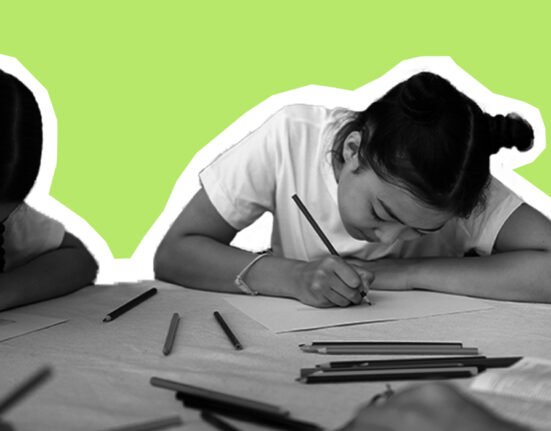Projective Tests are tools of evaluation used to explore the underlying emotional conflicts, unconscious motivations, and personality characteristics in children. In these tests, children are presented with ambiguous or unstructured stimuli that encourage the child to respond in a manner that mirrors the inner workings of their mind (Frick, P. J., et. al). Projective tools operate on the basic tenet of the projective hypothesis, which suggests that children project their internal experiences, such as fears and desires, onto the test stimuli, thereby revealing aspects of their psyche that usually remain hidden (Whitfill, T., et. al).
Read More: Unlocking Minds: Exploring the World of Psychological Tests
Types of Projective Techniques
Projective techniques are split into two major categories, which include drawing-based methods alongside narrative-based methods. Each category demonstrates dynamic characteristics that provide distinct, valuable perspectives. The assessment requirements,s along with child communication style and individual needs, determine the selection between these two methods (Santillo, G., et. al).
1. Drawing-Based Methods
Drawing techniques are used most often due to their accessibility and appeal to children. These include:
- Draw-A-Person (DAP): The child receives instructions to create a person so expert evaluators can analyse drawing details to understand emotional conditions and self-perception.
- House-Tree-Person (HTP): The test requires children to create drawings of houses alongside trees and human figures. The examiner uses these drawings to evaluate how the child understands family dynamics and personal development, and safety needs.
- Kinetic Family Drawing (KFD): Children draw family members doing an activity together. This helps in exploring family dynamics and roles.
- Draw-A-Family Picture Test: Focuses on relational attitudes, hierarchy, and emotional ties within the family.
2. Narrative-Based Methods
Children produce stories from images through narrative-based approaches that help reveal their emotional state and mental processes. These consist of:
- The Children’s Apperception Test (CAT): The CAT requires children to answer questions about cartoon drawings that show their psychological needs and emotional problems.
- Through the Thematic Apperception Test (TAT), children create human-based stories to explore motivational elements and emotional relationships with others.
- Drawn Story Technique: This type of work asks kids to illustrate something and then write a story to go with it. It provides information about how they process emotions and solve adaptive problems.
Read More: The Stories They Make up: Analysing Children’s Apperception Test (CAT)
Clinical Utility and Applications
Projective tests serve children best when verbal communication of their problems is limited and internalising symptoms like depression or anxiety are present. A child who refuses direct self-reporting will benefit more from indirect assessment methods. The assessment environment allows children to safely explore their emotions before clinicians use this protective method to build trust before discussing sensitive topics. The tests assist in diagnosing and planning interventions for intricate situations like trauma and behavioural problems, which do not yield enough understanding through direct questioning (Storey, R., et. al).
Use with Special Populations
Projective techniques deliver significant advantages to children who belong to marginalised or vulnerable groups. These strategies receive classification through two separate approaches.
- Children from low-income socioeconomic backgrounds: where trust and communication may play a role.
- Children who have experienced long-term trauma or abuse: To assess the emotional impacts that the kids might not be able to express verbally.
- Children who struggle with speech and neurodevelopmental issues: Nonverbal methods of gaining emotional insights cannot be supported by traditional methods.
These populations benefit from projective techniques, which provide a nonverbal approach for identifying emotional conditions that conventional tests fail to detect.
Read More: Humanistic and Existential Psychology: Foundations, Philosophies, and Contributions
Strengths of Projective Tests
Projective tests support emotional expression in a non-threatening way that makes children feel safe conveying their feelings. The qualitative nature of the tests provides a richer understanding of unconscious fears, relational dynamics, and other internalised emotions a child might carry. Thus, it makes them especially useful in psychodynamic and child-centred approaches. Projective tests promote rapport while engaging the vivid imagination of children, which can help reveal underlying issues that may go unnoticed in other traditional assessments.
Read More: From Denial to Humor: The Ladder of Our Mind’s Defenses
Common Criticisms and Limitations
Projective test evaluations naturally receive critical attention, but their inherent potential shortcomings need to be acknowledged (Whitfill, T., et. a,l & Santillo, G., et. al).
1. Concerns About Reliability and Validity
- Weak psychometric foundations: Assessment instruments often fail to demonstrate adequate validation because of their weak psychometric foundations.
- Low test–retest reliability: Children’s answers tend to change based on their current feelings and surroundings.
- Examiner subjectivity: Different clinicians obtain varying results from tests that lack standard normative scoring parameters.
2. Developmental and Cultural Constraints
Some children, especially younger ones, may lack the ability for abstract thinking demanded by some narrative tasks. Cultural context influences the interpretation given by children to stimuli and, if not taken into consideration, may yield a biased assessment.
Recent Developments and Research Trends
The scientific community focused on enhancing the scientific foundations of projective assessments through research conducted between 2010 and 2024. The main developments consist of:
- The development of scoring systems required researchers to establish standardised objective frameworks.
- Research focused on validating test applications through empirical investigations.
- Projective methods now benefit from improved reliability through their integration with interview techniques and observational methods.
The current generation of instruments demonstrates enhanced consistency when they are paired with structured tools, which suggests their potential value in evidence-based approaches.
Best Practices for Clinical Use
Projective tests demonstrate their maximum effectiveness in clinical practice when psychologists use them along with other assessment methods instead of relying on them alone. Psychologists need to introduce projective tools after they have established a positive connection with the child to make sure the child feels safe and comfortable.
The process generates authentic answers while boosting the probability of meaningful discoveries. The accurate interpretation of projective methods requires their combination with both structured assessments and clinical interviews, and behavioural observations. Obtaining collateral information from caregivers, along with teachers and other important adults in the child’s life, assists in validating the findings, which decreases the probability of subjective bias.
Projective tests deliver detailed data about emotional and psychological functioning when interpreted through a multimodal framework. This approach enhances diagnostic reliability and helps create more individualised treatment plans that prove to be more successful.
Role in Therapy and Treatment Planning
Projective tests help discover emotional conflicts, together with unmet needs and relational stressors. Therapists use this data to create their therapeutic plans. When children produce stories or drawings that repeatedly express feelings of danger or isolation, therapists should consider implementing trauma-informed care or family-based therapy. Treatment focuses on resolving fundamental issues instead of focusing on just observable behaviours. The assessment results enable clinicians to define treatment targets and monitor progress while developing therapeutic approaches that match the child’s internal world.
Read More: Therapeutic Alliance in Therapy
Ethical and Cultural Considerations
Projective techniques strictly require practitioners to exercise both sensitivity and ethical responsibility when conducting their assessments. The incorrect interpretation of test results emerges from cultural misunderstandings alongside developmental misinterpretations, which can cause harm. Therefore:
- Clinicians need proper training in delivering assessments that respect cultural differences.
- The evaluation of findings should take into account the individual history of the child.
- The process of obtaining informed consent should be followed by providing feedback which includes all caregivers.
These practices ensure ethical and meaningful use.
Conclusion
Projective tests present a strong method for understanding the inner psychological experiences of kids. These tests use their adaptable methods to discover thoughts and emotions that standard tests cannot detect. These tools demonstrate high practical value when applied with careful judgment as part of a multimodal assessment framework. The future of child psychology demands the ongoing development of projective methods combined with standard assessment approaches. When handled with proper care, these assessments enrich the evaluation process while generating therapeutic understanding that advances mental health and developmental support for their child population.
FAQ’s
Sure! Here are 6 brief FAQs based on the article on projective tests in child psychology:
1. What are projective tests in child psychology?
Projective tests are assessment tools that use unstructured or ambiguous stimuli to help children express hidden emotions, thoughts, and personality traits.
2. Why are projective tests useful for children?
They are helpful for children who struggle with verbal communication or are reluctant to speak openly. These tests offer a non-threatening way for children to share their feelings.
3. Which projective techniques are commonly used with children?
Common techniques include the Draw-A-Person test, House-Tree-Person, Kinetic Family Drawing, the Thematic Apperception Test, and the Children’s Apperception Test.
4. Can projective tests be used alone for diagnosis?
No, experts recommend using them as part of a larger assessment that includes structured tools, interviews, and observations for more reliable results.
5. What are the main criticisms of projective tests?
Critics point to concerns about low reliability, lack of standard scoring, and examiner subjectivity, which can affect the accuracy of results.
6. Are projective tests culturally sensitive?
They can be, but only if clinicians are trained to interpret responses within the child’s cultural and developmental context to avoid misjudgements.
References +
1. Frick, P. J., Barry, C. T., & Kamphaus, R. W. (2020). Clinical assessment of child and adolescent personality and behavior. In Springer eBooks. https://doi.org/10.1007/978-3-030-35695-8
2. Whitfill, T., Rossetti, H., and Gottlieb, M. C. (2015) ‘Psychological Testing and Assessment’, in John Z. Sadler, K. W. M. Fulford, and Werdie (C.W.) van Staden (eds), The Oxford Handbook of Psychiatric Ethics, Vol.2 https://doi.org/10.1093/oxfordhb/9780198732372.013.22
3. Santillo, G., Morra, R. C., Esposito, D., & Romani, M. (2025). Projective in Time: A Systematic review on the use of construction projective techniques in the digital Era—Beyond Inkblots. Children, 12(4), 406. https://doi.org/10.3390/children12040406
4. Storey, R., Gapen, M., & Sacco, J. S. (2014). Projective techniques and psychological assessment in disadvantaged communities. International Journal of Applied Psychoanalytic Studies, 11(2), 114–129. https://doi.org/10.1002/aps.1404













Leave feedback about this